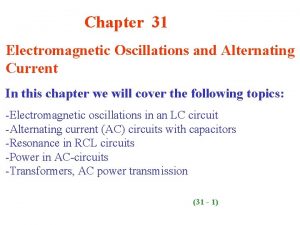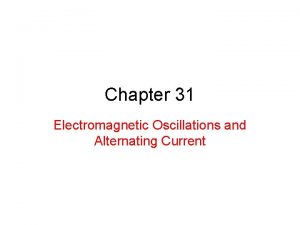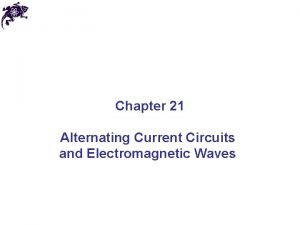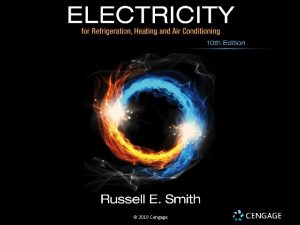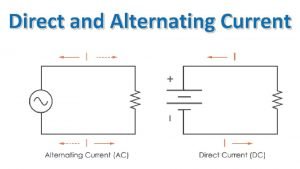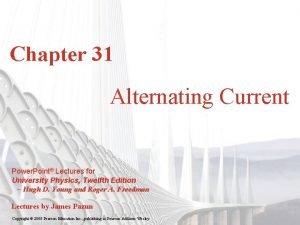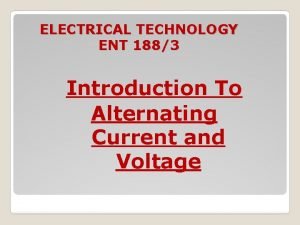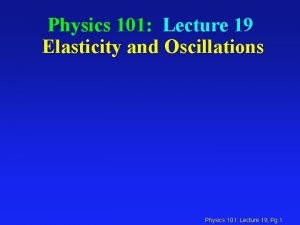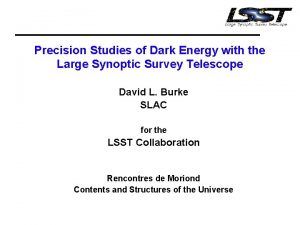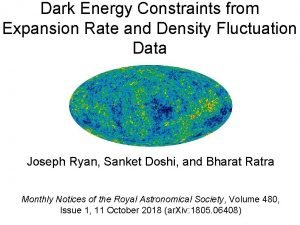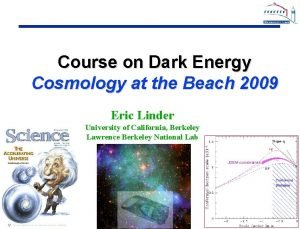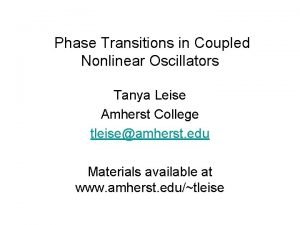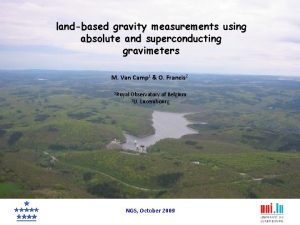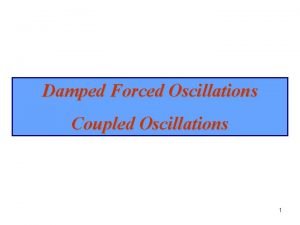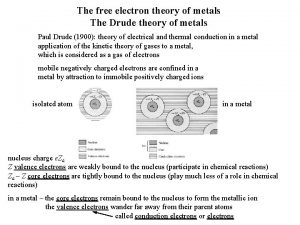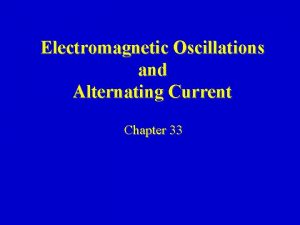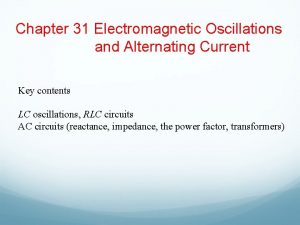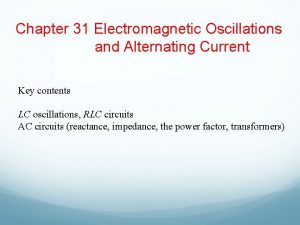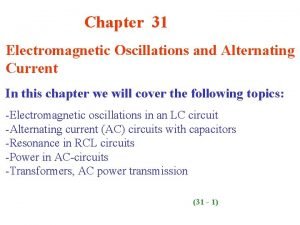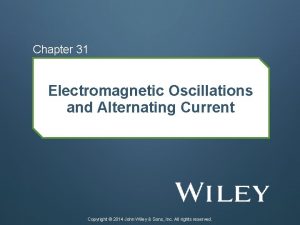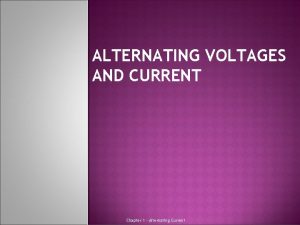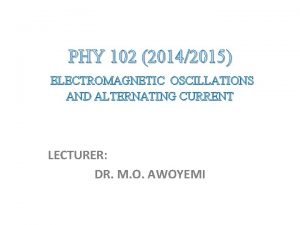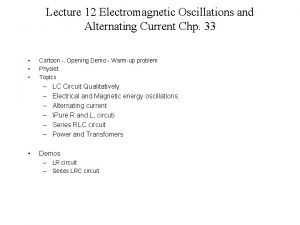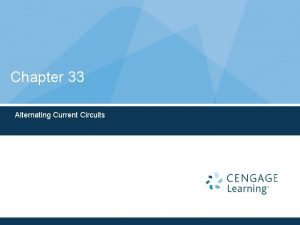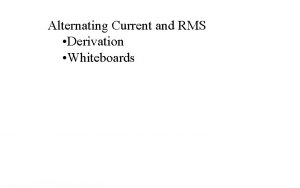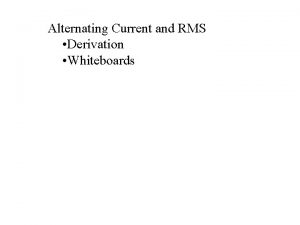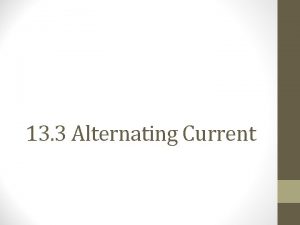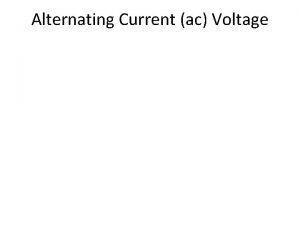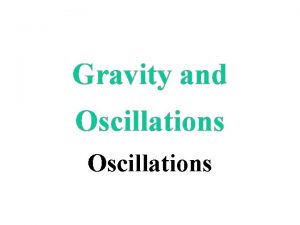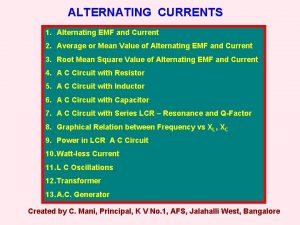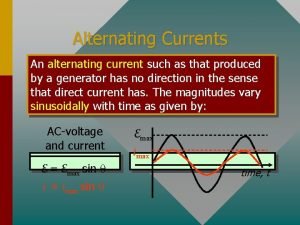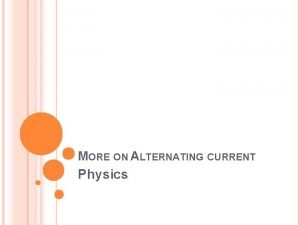Chapter 31 Electromagnetic Oscillations and Alternating Current Key

































- Slides: 33

Chapter 31 Electromagnetic Oscillations and Alternating Current Key contents LC oscillations, RLC circuits AC circuits (reactance, impedance, the power factor, transformers)

LC Oscillations:

The Electrical Mechanical Analogy: The angular frequency of oscillation for an ideal (resistanceless) LC is:

LC Oscillations, Quantitatively: The Block-Spring Oscillator: The LC Oscillator: Pay attention to the direction of the defined i.

LC Oscillations, Quantitatively: The electrical energy stored in the LC circuit at time t is, The magnetic energy is: But Therefore

Example, LC oscillator, potential charge, rate of current change

Damped Oscillations in an RLC Circuit:

Damped Oscillations in an RLC Circuit: Analysis: Where And

Example, Damped RLC Circuit:

Alternating Current: wd is called the driving angular frequency, and I is the amplitude of the driven current.

Forced Oscillations:

Three Simple Circuits: i. A Resistive Load: For a purely resistive load the phase constant f = 0°. # We are concerned with the potential drop (voltage) along the current flow, and the phase lag of the current w. r. t. the voltage.

Three Simple Circuits: i. A Resistive Load:

Example, Purely resistive load: potential difference and current

Three Simple Circuits: ii. A Capacitive Load: XC is called the capacitive reactance of a capacitor. The SI unit of XC is the ohm, just as for resistance R.

Three Simple Circuits: ii. A Capacitive Load:

Example, Purely capacitive load: potential difference and current

Three Simple Circuits: iii. An Inductive Load: The XL is called the inductive reactance of an inductor. The SI unit of XL is the ohm.

Three Simple Circuits: iii. An Inductive Load:

Example, Purely inductive load: potential difference and current

Three Simple Circuits:

The Series RLC Circuit: Fig. 31 -14 (a) A phasor representing the alternating current in the driven RLC circuit at time t. The amplitude I, the instantaneous value i, and the phase(wdt-f) are shown. (b) Phasors representing the voltages across the inductor, resistor, and capacitor, oriented with respect to the current phasor in (a). (c) A phasor representing the alternating emf that drives the current of (a). (d) The emf phasor is equal to the vector sum of the three voltage phasors of (b). Here, voltage phasors VL and VC have been added vectorially to yield their net phasor (VL-VC).

The Series RLC Circuit: (! f is the phase lag w. r. t. the emf. )

The Series RLC Circuit, Resonance: For a given resistance R, that amplitude is a maximum when the quantity (wd. L -1/wd. C) in the denominator is zero. The maximum value of I occurs when the driving angular frequency matches the natural angular frequency—that is, at resonance.

The Series RLC Circuit, Resonance:

Power in Alternating Current Circuits: The instantaneous rate at which energy is dissipated in the resistor: The average rate at which energy is dissipated in the resistor, is the average of this over time: The factor cos ϕ is called the power factor. Since the root mean square of the current is given by: To maximize the power supplied to a resistive load, a larger power factor is desired. Similarly, With Therefore, where

Example, Driven RLC circuit:

Example, Driven RLC circuit, cont. :

Transformers:

Transformers: Because B varies, it induces an emf in each turn of the secondary. This emf per turn is the same in the primary and the secondary. Across the primary, the voltage Vp =Eturn Np. Similarly, across the secondary the voltage is Vs =Eturn. Ns.

Transformers: If no energy is lost along the way, conservation of energy requires that Here Req is the value of the load resistance as “seen” by the generator. For maximum transfer of energy from an emf device to a resistive load, the resistance of the load must equal the resistance of the emf device. For ac circuits, for the same to be true, the impedance (rather than just the resistance) of the load must equal that of the generator.

Example, Transformer:

Key contents LC oscillations, RLC circuits AC circuits (reactance, impedance, the power factor, transformers)
 Electromagnetic oscillations and alternating current
Electromagnetic oscillations and alternating current Electromagnetic oscillations and alternating current
Electromagnetic oscillations and alternating current Alternating current circuits and electromagnetic waves
Alternating current circuits and electromagnetic waves Chapter 7 alternating current
Chapter 7 alternating current Direct and alternating current
Direct and alternating current Ac current graph
Ac current graph Alternating current ppt
Alternating current ppt Line regulation
Line regulation Vrms to vpp
Vrms to vpp Direct current transformer
Direct current transformer Elasticity and oscillations
Elasticity and oscillations Baryon acoustic oscillations
Baryon acoustic oscillations Joint play grading
Joint play grading Baryon acoustic oscillations
Baryon acoustic oscillations Baryon acoustic oscillations
Baryon acoustic oscillations Baryon acoustic oscillations
Baryon acoustic oscillations Baryonic acoustic oscillations
Baryonic acoustic oscillations Coupled oscillations
Coupled oscillations Slow oscillations
Slow oscillations Coupled pendulum
Coupled pendulum Drude model
Drude model Plasma oscillations
Plasma oscillations Lotka-volterra predator-prey model
Lotka-volterra predator-prey model A balanced delta connected load having an impedance 20-j15
A balanced delta connected load having an impedance 20-j15 Line current and phase current
Line current and phase current Energy band diagram of pnp transistor
Energy band diagram of pnp transistor Ac systems lesson 4
Ac systems lesson 4 Drift current
Drift current Drift current and diffusion current in semiconductor
Drift current and diffusion current in semiconductor Balanced delta-delta connection
Balanced delta-delta connection Holding current and latching current
Holding current and latching current Diffusion current formula
Diffusion current formula Gm formula for mosfet
Gm formula for mosfet In alternators the welding current is produced on the ____.
In alternators the welding current is produced on the ____.
